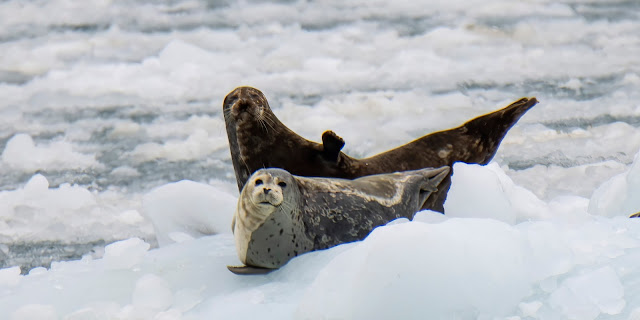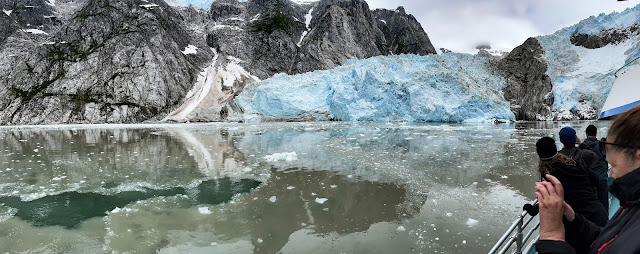 |
| A good trip |
In the past, I have gone with both Kenai Fjords and Major Marine. Both are good.
I selected the seven-hour trip to Northwestern Glacier (the Northwestern Fjord Tour), which is the longest trip – to the farthest-away glacier – that Kenai Fjords Tours offers. I have done this trip before and it certainly delivers.
 |
| The route |
I said it was the longest trip, at seven hours. Major Marine offers an 8.5-hour tour, but I am not sure if it was available yet because it was early in the season. I didn’t pursue it because a too-long tour wouldn’t mesh my schedule with Scott’s fishing schedule.
Compared to previous tours, there was a lot less glacier action, but some really good wildlife and more attention to birds than I have ever (consciously) experienced on this trip. It is possible that I just didn’t notice as much when I wasn’t into birding.
But, I actually think there was more attention to birds for two reasons: first, based on his knowledge and comments, I believe the captain (Capt. Lindstrom to be precise) was a birder; second, a rather large birding group with a guide was on board. That worked for me. I definitely benefited from standing near a birding guide.
The Trip
The tour started at the harbor in Seward, heading out through Resurrection Bay with its steep mountains on the sides.
Explorer Alexandr Baranov named the bay after the storm he was sheltering from abated on Easter Sunday.
We stopped briefly at Fox Island, where Pursuit operates the Kenai Backcountry Lodge, to take on and discharge passengers. Capt. Lindstom said it would be a quick stop and he was not kidding. Five minutes tops.
 |
| Fox Island |
Then, the boat entered the Gulf of Alaska with open ocean to the east and the coastline to the west. We could see snow-covered mountains and glaciers along the way.
One impressive glacier is the Bear Glacier, which faces the open water and appears to be a no-brainer for tours to visit.
 |
| Bear Glacier |
But, you can’t get there in a boat because a terminal moraine blocks entry, holding the glacial outfall in a lagoon in front of the glacier.
Then, we passed Aialik Bay, which heads up towards Aialik and Holgate Glaciers. Most tours go here instead of going on the Northwestern.
We also passed through the Chiswell Islands at the mouth of Aialik Bay.
This is a fantastic birding spot. I’ll talk about all the birds we saw, many at Chiswell, later.
 |
| A great place for seabirds |
But, we pressed on, eventually turning and heading up Northwestern Fjord to the face of the glacier.
To reach the glacier, the boat passes over a submerged terminal moraine that creates interesting currents and eddies. The tide was exceptionally low the day we went, so the swirling water was more obvious.
The Glacier
Now, you might wonder why the more southerly glacier is named Northwestern. It has nothing to do with location. Rather, it was named in 1909 by scientists from (you guessed it) Northwestern University who were studying the glaciers in the area. Holgate Glacier is named after Dr. Thomas F. Holgate, Dean of the College of Liberal Arts of Northwestern University at the time.
A tidewater glacier, Northwestern has been steadily receding over the past century. By the second half of the 20th century, Northwestern Glacier's recession revealed a number of islands in the Fjord that had previously been covered in ice.
 |
| Clockwise: 2001, 2013, 2022 |
To me, it seemed greatly reduced from when I had been before.
But, then, I looked at a photo I took in 2013 and it looked pretty close.
Then, I looked at a photo I took in 2001 and I see a difference at the higher up, back portion of the glacier.
Why?
Well, because the bay at the face of the glacier was absolutely filled with ice. So much that Capt. Lindstrom had to take the boat gingerly around the edge to get safety close enough to the glacier for good viewing.
 |
| Approaching the glacier |
This is not particularly unusual, glaciers calve large chunks of ice that fall into the water as either icebergs (big), bergies (medium) or brash (small).
 |
| Brash |
What was unusual is that Capt. Lindstrom said that the day before the bay had been completely clear. Completely. That means that a MAJOR calving event had taken place overnight or that morning. This was the result.
 |
| What happened? |
And, that (probably) meant that we wouldn’t see a lot of calving. At least that is what I assumed because I theorized that all the really loose stuff had already fallen.
It turns out that I was right. There was a fair (smallish, but fair) amount of booming and cracking, but we saw very few actual calving events.
 |
| There was one fairly good event |
A lot of what was happening seemed to be going up high behind and above the part of the glacier that reached the ocean.
Now, this isn’t surprising because, once rock is exposed as a glacier erodes, the erosion speeds up. You see, glaciers are light – white and blue – and, therefore, reflect sunlight.
 |
| Keeping it cool |
The underlying rock is dark and, therefore, absorbs sunlight. That heats the rock, which melts more ice, which exposes more rock, which heats up …
 |
| Getting warmer |
So, as you can see, the more a glacier recedes, the faster the recession tends to occur.
That’s unfortunate. But, it’s how it goes.
And, that calving (whether it occurs high up and tumbles its way down or drops directly in the ocean) creates an icy, slushy, brashy area around the glacier.
Sometimes, like the day we were there, it makes approach difficult.
 |
| An interesting day to kayak |
But, tides pull the ice away and warmer water and the sun melts it. So, some days the bay is completely clear like, according to Capt. Lindstrom, the day before.
It was a bit overcast on the day we went and I had hoped that it would clear when we reached the Northwestern Glacier. That is not unusual. Because of temperature differences caused by the giant expanse of ice, glaciers sometimes “make their own weather,” being clear when everything else is overcast or cloudy when everything else is clear. This was not the case.
Despite overcast skies, we had some really nice reflection – even through the brash.
 |
| A great reflection |
Another weather fact about glaciers is that they can make wind. It's called the "Katabatic” wind.
It happens when air meeting the
the cold air around the glacier becomes chilled itself. Since colder air is denser than warm air, the chilled air floats down the face of the glacier.
Katabatic wind is felt strongest during the fall when the climate is warmer in the valleys but getting colder above. But, it can also happen in summer.
That’s why you must always dress warmly for a glacier tour.
It’s not unusual to be very warm in town, but absolutely freezing at the glacier face. Plus, the water in the Gulf of Alaska is quite chilly and even colder near the glacier and that affects air temperature.
Now, even though we had a lot of overcast. We also had some sunny (well, partly cloudy) sky, too. That’s Alaska for you.
 |
| Some pretty sky |
Harbor Seals
When there is ice floating around the glacier, it provides a great habitat for Harbor Seals, which haul out on the larger pieces of ice (bergs and bergies) to get a bit of relief from the cold water, which at the face of the glacier hovers around freezing...
 |
| Harbor Seals watching us |
I wrote about Harbor Seals in one of my Iceland blogs.
Yep, these roly poly little critters live in coastal waters of the northern Atlantic, Pacific Oceans, Baltic and North Seas. In Alaska, you can find them lots of places near the shore or hauled out on rocks. But, they like the glacier face because the floating ice gives them a safe place to go to escape their primary predator, the Orca.
 |
| Mother and pup |
They use these floating safe zones to rest, birth and nurse their pups, and to molt later in the summer. They're generally safe when they're on the iceberg.
When the tour boat approaches, they are wary, often slipping into the water as we get close.
 |
| In the water! |
 |
| Can't stay forever (drat!) |
Gotta Go
After exploring the glacial area for a little while and taking lots of photos, Capt. Lindstrom said that we needed to leave for two reasons: we needed to get back to port in time and there were lots of other things to see.
I’m good with seeing other things.
So, we pulled away from the glacier, taking some last looks …
 |
| Good-bye |
… passing a diving Humpback Whale …
… a cool glacial tunnel carved in the base by underglacier melting …
 |
| Ice cave |
… and a mama Sea Otter tightly clutching her baby …
 |
| A Queen (that's what you call a female Sea Otter) and her pup |
Capt. Lindstrom told us that he would not stop for or approach the Otter because babies don’t have enough body fat to float (which is why they stay on their mother’s tummies when young). If frightened by the boat, the mother would dive, which would be a stressor for both mom and baby.
This glacier trip is far from over and there are a lot of things we saw both on the way to and from Northwestern Glacier that I haven’t discussed yet. But, this post is getting long, so I’ll cover all that in the next post.
 |
| A final look |
But, here’s a video to close it out.
Trip date: June 16-24, 2022









No comments:
Post a Comment